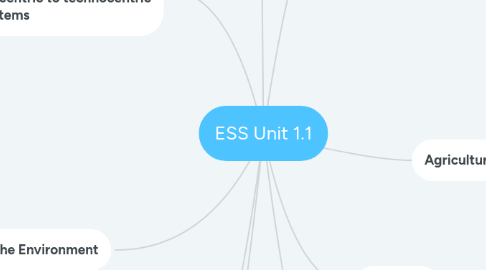
1. What is EVS?
1.1. An EVS is a perspective or framework that influences how a person or a group of people views or analyzes environmental concerns, based on cultural, religious, economic, and socio-political contexts.
1.1.1. An environmental value system is a system in the sense that it has;
1.1.1.1. inputs - education,cultural influences, religious doctrine, media)
1.1.1.2. outputs - decisions, perspectives, courses of action determined by processing these inputs.
2. There is a spectrum of EVSs, from ecocentric through anthropocentric to technocentric value systems
2.1. Ecocentrism
2.1.1. They believe that;
2.1.1.1. As resources are limited, we must be cautious in our use of them.
2.1.1.2. The planet is home to all living things, including animals, plants, and humans.
2.1.1.3. Natural processes should be disturbed as little as possible.
2.2. Anthropentrecism
2.2.1. An anthropocentric viewpoint asserts that people must manage the global system in a sustainable manner. This could be accomplished by the implementation of taxes, environmental regulations, and legislation. Debate would be encouraged in order to arrive at a consensus-based, realistic solution to environmental issues.
2.2.1.1. compensation arrangements are made satisfactory for people who experience bad environmental and social effects
2.3. Technocentrism
2.3.1. This is technology centered. When people believe that technology can protect the environment.
2.4. Comucopians believe that the earth has enough resources and there won’t be any severe impacts.
2.5. The deep ecologists believe that they should value nature. They believe that resources are limited and we must be cautious when using them.
3. Value of the Environment
3.1. Commodities (Goods and Services)
3.2. Inrinsic (ethical, spiritual, philosophical)
4. Industrial Revolution
4.1. transition from mid 1700's to mid 1800's
4.2. human labour to machine labour
4.3. urbanization
4.4. increase natural resource consumption
4.5. conversationsists begin to get involved
5. Modern Environmental Movement
5.1. 1960's
5.2. rise of environmentalists
5.3. NGOs, governments, public awareness
6. Significant Historical Influences
6.1. Minimata Disease
6.1.1. Minamata disease is a methylmercury poisoning with neurological symptoms that is induced by consuming huge numbers of fish and shellfish that have been severely contaminated with the deadly chemical produced in chemical companies and then released into the sea on a daily basis.
6.2. Cuyahoga River
6.2.1. With the tragic fire in 1969, the Cuyahoga River had become extremely flammable due to the large amount of oil in it. The river turned into a dead river, meaning it was lacking oxygen. Since there was no oxygen in the river, no plant or animal life could survive. It was polluted by sewage from Akron and Cleveland, and the steel and automobile industries.The 1972 Clean Water Act established a number of restrictions on what could be discharged in bodies of water. Many rules were implemented to prevent sewage from entering the river.
6.3. Bhopal Disaster
6.3.1. The Bhopal disaster occurred when a pesticide facility released massive amounts of a very hazardous chemical called methyl isocyanate (MIC) into the environment. Inadequate hazard management, poor safety management practices, poor use of early warning systems, poor awareness of the danger involved, and so on were all contributing factors.Former Union Carbide employees and leaders of the organizations demanded that the state government modify its stance on toxic waste dumped by Union Carbide, and instead of excavating hundreds of tonnes of hazardous material that is contributing to Bhopal's ever-increasing contamination, the state government planned to build concrete on the poisoned area as a tribute to the accident.
7. Literature
7.1. Silent Spring
7.1.1. Rachel Carson, a marine biologist and author, is regarded as one of history's most influential conservationists and the "Mother of Modern Environmentalism." Her findings led to a nationwide ban on DDT and other pesticides.
7.1.2. The powerful—and frequently negative—effect humans have on the natural world is the central theme of Silent Spring. Carson's major point is that pesticides are bad for the environment, and that they should be called "biocides" instead of pesticides because their effects are rarely limited to pests.
